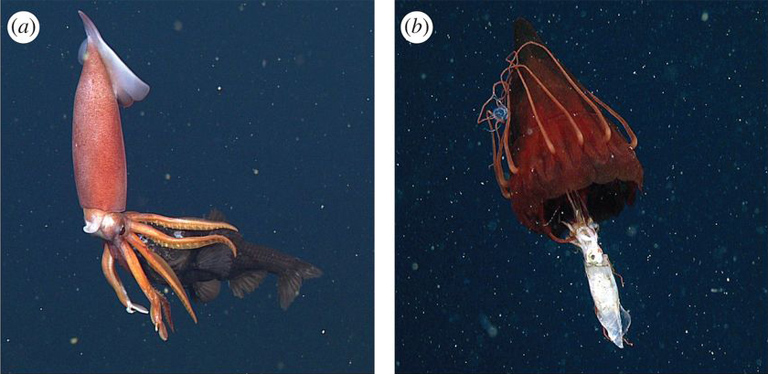- Scientists have for the first time captured extensive visual documentation of deep-sea food webs using 27 years’ worth of video observations from remotely operated vehicles run by the Monterey Bay Aquarium Research Institute (MBARI).
- The research greatly enhances scientists’ understanding of deep-sea food webs by documenting the importance of soft-bodied predators like jellyfish.
- Until now, our understanding of food webs in the deep ocean have been limited by what can be captured by net and whose bodies survive a journey to the survey.

Scientists have for the first time captured extensive visual documentation of predation events that underpin deep-sea food webs. The research, which relies on hundreds of video observations captured over nearly three decades by deep-diving remotely operated vehicles run by the Monterey Bay Aquarium Research Institute (MBARI), reveals the importance of deep-sea jellies in these ecosystems as major predators and sources of sustenance.
Until now, our understanding of food webs in the deep ocean have been limited by what species can be captured by net and whose bodies can survive a journey to the surface. That meant soft-bodied, gelatinous animals like jellyfish have been greatly underrepresented using traditional surveying techniques. MBARI’s approach enabled researchers Anela Choy, Steven Haddock, and Bruce Robison to capture deep-sea predators in the act of feeding, offering new insight into predator-prey relationships at depths up to nearly 4,000 meters (13,000 feet) off the California coast.
“This direct approach has never been used systematically before,” Robison said in a statement. “Unlike other methods, it involves no guesswork and provides very precise information about who eats whom in the deep sea.”

The research, which is published in the December 6th issue of the Proceedings of the Royal Society B, identified 84 different predators and 82 different prey types across almost 750 different video observations of predation events. Soft-bodies animals Ô medusae, ctenophores and siphonophores — consumed the greatest diversity of prey, outpacing cephalopods like squid.
“The most surprising thing to me was how important gelatinous animals were as predators, and how their unexpectedly complex food habits spanned the entire food web. Who would have thought that a deep-sea jelly that looks like a big dinner plate would eat 22 different types of animals?” lead author Anela Choy, a MBARI Postdoctoral Fellow, said via a news release. “Our video footage shows that jellies are definitely not the dietary ‘dead ends’ we once thought. As key predators, they could have just as much impact as large fishes and squids in the deep sea!”


The findings show that jellies play a critical role in deep-sea ecosystems, added Haddock.
“There is a misconception that jellies are merely a nuisance and serve no real purpose in marine ecosystems,” he said in a statement. “Our results and other studies around the world show that they are a common source of food for a diverse group of predators. Interactions involving gelatinous predators and prey create most of the complexity that we see in our new deep-sea food web.”

Citation:
- Choy, C.A., Haddock, S.H.D. Robison, B.H. (2017). Deep pelagic food web structure as revealed by in situ feeding observations. Proceedings of the Royal Society B. 284: 20172116, doi: 10.1098/rspb.2017.2116 (6 December 2017)
